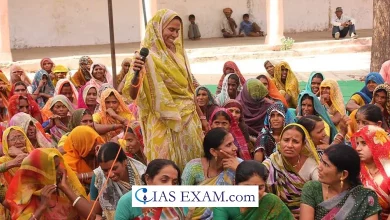NITI Aayog Roadmap to Boosts MSME Exports
Syllabus: Economy[GS Paper-3]

Context
The NITI Aayog has suggested several actions to increase exports from micro, small, and medium enterprises. These actions include enhancing e-commerce exports, establishing a trade portal, improving the process of merchandise exports, facilitating access to export finance, and creating a centralised information platform for exporters.
Details on News
The NITI Aayog’s roadmap to boost MSME exports is a strategic plan formulated by the Indian government’s policy think tank to enhance the export potential of the Micro, Small, and Medium Enterprises (MSME) sector.
- Objectives and Goals
-
-
- Enhancing Global Presence: The primary aim is to strengthen the presence of Indian MSMEs in global markets.
- Economic Growth: By boosting MSME exports, the roadmap contributes to overall economic growth and job creation.
-
- Key Strategies
-
- Policy Reforms: The policy design should entail creating a friendlier setting for MSMEs that will help them grow and compete favourably on the international scene.
- Infrastructural Development: Advancement of engineering designs and structures for MSMEs to increase their ability to yield more products and make the delivery to a broad market.
- Focus Areas
-
-
- Technology and Innovation: To achieve it, we can utilize the advantages of modern technologies and promote small and medium sized enterprises creativity.
- Skill Development: Delivering the training and development schemes to increase the employees’ functionality and skills within the MSME sector.
-
- Challenges Addressed
-
-
- Financial Access: Improving the finance for the middle and small level businesses for the expansion and modernization of their business.
- Regulatory Framework: Facilitating the process of licensing and permits of MSME by the institutions of regulatory bodies to ensure a fast and uninterrupted business flow.
- Market Access: Offering MSMEs a wider range of opportunities to participate in both home and foreign markets becomes accessible.
-
- Collaboration and Partnerships
-
-
- Government Cooperation: Working at a close level with government departments and agencies with a joint aim of providing all required assistance and support.
- International Tie-ups: Establish sharing agreement with international agencies and different countries to give Indian MSMEs access to new market outlets.
-
- Implementation and Monitoring
-
-
- Action Plans: Creation of actionable plans for the health, education, and transport small and medium enterprises (SME) subsectors and i.e.
- Regular Assessment: Implementing regular track record check and making modifications in strategies if recommendations are needed.
-
- Long-term Vision
-
- Sustainable Growth: Steering towards the sustainability and inclusiveness of the Small and Medium- sized Enterprise Sector helping India’s GDP, a lot.
- Global Competitiveness: Place Indian MSMEs as global competitors that bring a significant contribution to world trade through a framework which caters network and equality.
NITI Aayog
-
- Established: January 1, 2015.
- Replaced: Planning Commission, a legacy institution.
- Objective: To provide strategic policy advice to the central and state governments.
- Organisational Structure:
- Governing Council: Comprises all state Chief Ministers, Lieutenant Governors of Union Territories, and several Union Ministers.
- Chairperson: The Prime Minister of India.
- Vice Chairperson and CEO: Appointed by the central government, these positions are key to the operational management of NITI Aayog.
- Functions and Roles:
-
-
- Policy Formulation: Assists in crafting strategic and long-term policies and programs.
- Advisory Role: Offers technical advice to the Central and State Governments.
- Monitoring and Evaluation: Evaluates the implementation of programs and initiatives.
- Sustainable Development Goals (SDGs): Works towards achieving the SDGs through national and state-level strategies.
-
- Key Initiatives:
-
- Aspirational Districts Programme: Aims to rapidly transform districts that have shown relatively less progress in key social areas.
- Atal Innovation Mission: Promotes a culture of innovation and entrepreneurship across the country.
- Think Tank Functions: Provides a platform for resolving inter-sectoral and inter-departmental issues to accelerate the implementation of the development agenda.
Conclusion
NITI Aayog’s roadmap for MSME export enhancement is a key component of India’s economic strategy, aiming to transform the country into a $5 trillion economy by 2030. This plan, forming a part of the “Strategy for New India @ 75,” emphasises collaboration across various stakeholders, focusing on policy refinement, innovation, skill development, and infrastructural advancement. The successful execution of this strategy is crucial for the global positioning and economic contribution of India’s MSME sector.
Source: Business standard
UPSC Prelims Practice Question
Q.Which of the following statements is/are correct about NITI Aayog?
- NITI Aayog was established to replace the Planning Commission.
- It is a constitutional body.
- NITI Aayog’s aim includes fostering cooperative federalism through structured support initiatives to states.
Select the correct answer using the code given below:
a. 1 only b. 2 and 3 only
c. 1 and 3 only d. All of the above
Ans – “c”





.png)



